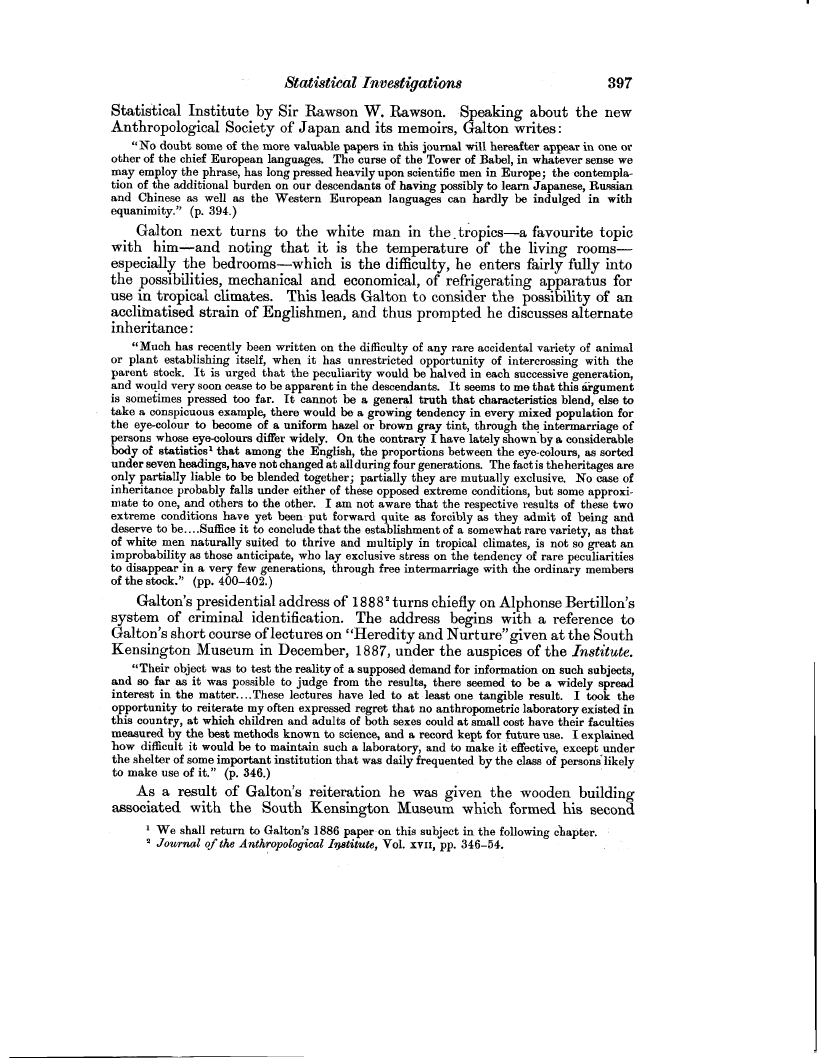Statistical Investigations 397
Statistical Institute by Sir Rawson W. Rawson. Speaking about the new Anthropological Society of Japan and its memoirs, Galton writes
"No doubt some of the more valuable papers in this journal will hereafter appear in one or other of the chief European languages. The curse of the Tower of Babel, in whatever sense we may employ the phrase, has long pressed heavily upon scientific men in Europe; the-contemplation of the additional burden on our descendants of having possibly to learn Japanese, Russian and Chinese as well as the Western European languages can hardly be indulged in with equanimity." (p. 394.)
Galton next turns to the white man in the. tropics-a favourite topic with him-and noting that it is the temperature of the living roomsespecially the bedrooms-which is the difficulty, he enters fairly fully into the possibilities, mechanical and economical, of refrigerating apparatus for use in tropical climates. This leads Galton to consider the possibility of an acclimatised strain of Englishmen, and thus prompted he discusses alternate inheritance
"Much has recently been written on the difficulty of any rare accidental variety of animal or plant establishing itself, when it has unrestricted opportunity of intercrossing with the parent stock. It is urged that the peculiarity would be halved in each successive generation, and would very soon cease to be apparent in the descendants. It seems to me that this argument is sometimes pressed too far. It cannot be a general truth that characteristics blend, else to take a conspicuous example, there would be a growing tendency in every mixed population for the eye-colour to become of a uniform hazel or brown gray tint, through the intermarriage of persons whose eye-colours differ widely. On the contrary I have lately shown by a considerable body of statistics' that among the English, the proportions between the eye-colours, as sorted under seven headings, have not changed at all during four generations. The fact is the heritages are only partially liable to be blended together; partially they are mutually exclusive. No case of inheritance probably falls under either of these opposed extreme conditions, but some approximate to one, and others to the other. I am not aware that the respective results of these two extreme conditions have yet been put forward quite as forcibly as they admit of being and deserve to be.... Suffice it to conclude that the establishment of a somewhat rare variety, as that of white men naturally suited to thrive and multiply in tropical climates, is not so great an improbability as those anticipate, who lay exclusive stress on the tendency of rare peculiarities to disappear in a very few generations, through free intermarriage with the ordinary members of the stock." (pp. 400-402.)
Galton's presidential address of 18882 turns chiefly on Alphonse Bertillon's system of criminal identification. The address begins with a reference to Galton's short course of lectures on "Heredity and Nurture" given at the South Kensington Museum in December, 1887, under the auspices of the Institute.
"Their object was to test the reality of a supposed demand for information on such subjects, and so far as it was possible to judge from the results, there seemed to be a widely spread interest in the matter... .These lectures have led to at least one tangible result. I took the opportunity to reiterate my often expressed regret that no anthropometric laboratory existed in this country, at which children and adults of both sexes could at small cost have their faculties measured by the best methods known to science, and a record kept for future use. I explained how difficult it would be to maintain such a laboratory, and to make it effective, except under the shelter of some important institution that was daily frequented by the class of persons likely to make use of it." (p. 346.)
As a result of Galton's reiteration he was given the wooden building associated with the South Kensington Museum which formed his second
' We shall return to Galton's 1886 paper on this subject in the following chapter. 2 Journal of the Anthropological Institute, Vol. xvii, pp. 346-54.

